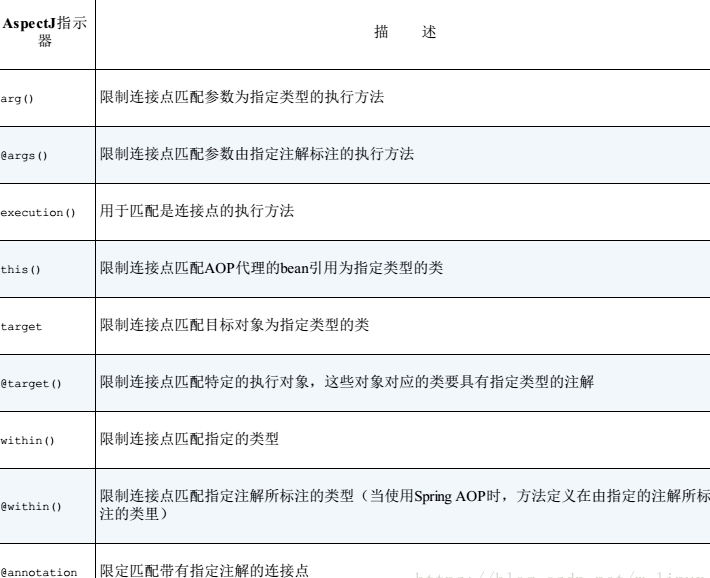除了IOC外, AOP是Spring的另一个核心. Spring利用AOP解决应用横切关注点(cross-cutting concern)与业务逻辑的分离, 目的是解耦合. 横切关注点是指散布于代码多处的同一种功能, 比如日志, 事务, 安全, 缓存等.
AOP编程的基本概念
在OOP中, 如果要复用同一功能, 一般的做法是使用继承或委托. 继承容易导致脆弱的对象体系, 而委托实现起来比较麻烦, 需要对委托对象进行复杂调用. AOP提供了另外一种思路, 使用AOP我们仍然可以在一个地方定义功能, 并通过声明的方式告知何处以哪种方式使用这个功能. 这样我们既可以对功能做统一管理和维护, 同时也简化了业务逻辑模块, 使其更关注自身的业务逻辑. 此外, AOP还可以将新的功能行为添加到现有对象.
Spring中AOP的术语
- 切面(Aspect): 切面定义了横切关注点的功能以及使用该功能的声明. 它包含了另外两个术语, 通知(Advice, 功能逻辑代码)和切点(Pointcut,声明). 切面定义了它是什么(what), 以及在何时何处(when,where)完成其功能.
- 通知(Advice): 通知定义了切面的具体功能, 以及何时使用.
when,何时使用? 前置(Before), 后置(After), 返回(After-returning), 异常(After-throwing), 环绕(Around)
- 切点(Pointcut): 定义了切面定义的功能在哪里(Where)发生作用, 看起来就像从某个点把切面插入进去一样. 切点应该属于连接点中的一个或多个.
- 连接点(Join point): 定义了程序执行过程中可以应用切面的具体时机, 比如方法调用前, 调用后, 结果返回时, 异常抛出时等, 通常某个具体切面只会选择其中一个或几个连接点作为切点.
- 引入(Introduction): 为现有的类添加新的方法或属性叫引入.
- 织入(Weaving): 织入是把切面应用到目标对象并创建新代理对象的过程.
织入的方式有三种:
- 编译期: 需要特殊的编译器支持, 如AspectJ的织入编译器
- 类加载期: 需要特殊的类加载器ClassLoader
- 运行时: Spring AOP 使用该方式织入. AOP容器为对象动态创建一个代理对象.
Spring 对 AOP的支持
Spring对AOP的支持很多借鉴了AspectJ的方式.
Spring支持四种方式的织入:
- 基于代理的经典AOP; (方式太老旧, 不建议使用)
- 纯POJO切面;(需要XML配置)
- @AspectJ 注解驱动的切面; (没啥说的,很好用)
- 注入式AspectJ切面;
- 前三种都是基于动态代理实现, 因此Spring对AOP的支持局限于方法拦截. 如果前三种满足不了需求(比如拦截构造器方法或者字段修改), 可以使用第四种.
- 与AspectJ不同, Spring的切面就是Java类, Spring使用运行时动态代理, 而AspectJ需要学习特殊的语法以支持特殊的编译器织入.
通过切点来选择连接点
Spring 借鉴了AspectJ的切点表达式语言. 如前所述, Spring基于动态代理,只能在方法上拦截, 所以Spring只支持这个层面的表达式来定义.
spring支持的AspectJ指示器如下, 其中execution来执行匹配, 其他均为限制匹配的.

切点表达式更多使用可以参考官方文档
- spring新增了个bean()指示器
使用注解创建切面
一. 定义切面类, 并用 @Aspect注解, 该注释用来标记这个类是个切面
二. 定义切面的方法(what), 并使用注解标记方法(when), 可用的注解: @Before,@After,@AfterReturning,@AfterThrowing,@Around(功能最强大,后面将单独使用这种通知)
一,二步完成后的代码:
@Aspect
public class Audience{
@Before("execution(** com.xlx.Performance.perform(...))")
public void silencephone(){
System.out.println("silencephone");
}
@Before("execution(** com.xlx.Performance.perform(...))")
public void takeSeats(){
System.out.println("takeSeats");
}
@AfterReturning("execution(** com.xlx.Performance.perform(...))")
public void applause(){
System.out.println("applause");
}
@AfterThrowing("execution(** com.xlx.Performance.perform(...))")
public void refund(){
System.out.println("refund");
}
}上面的代码中切面表达式被重复定义了四次, 无论如何这已经是重复代码了, 下一步优化一下.
三. 使用注解@Pointcut定义切点
@Aspect
public class Audience{
//定义切点并修改其他方法重用该切点
@Pointcut("execution(** com.xlx.Performance.perform(...))")
public void performance(){
}
@Before("performance()")
public void silencephone(){
System.out.println("silencephone");
}
@Before("performance()")
public void takeSeats(){
System.out.println("takeSeats");
}
@AfterReturning("performance()")
public void applause(){
System.out.println("applause");
}
@AfterThrowing("performance()")
public void refund(){
System.out.println("refund");
}
}@Aspect注解的类依然是个普通java类, 它可以被装配为bean
@Bean
public Audience getAudience(){
return new Audience();
}四. 使用@EnableAspectJAutoProxy注解启用自动代理功能, 如果是XML Config ,对应的节点是<aop:aspectj-autoproxy />
@Configuration
@ComponentScan // 包扫描
@EnableAspenctJAutoProxy // 启动自动代理
public class MyConfig{
// 如果Audience上加了@Component就不需要这个代码了
@Bean
public Audience getAudience(){
return new Audience();
}
}五. 使用环绕通知@Around, 环绕通知同时兼具了@Before,@After ... 等注解的方法的功能, 下面代码演示了这种能力. 如可以使用它记录方法执行时长.
@Aspect
public class Audience{
//定义切点并修改其他方法重用该切点
@Pointcut("execution(** com.xlx.Performance.perform(...))")
public void performance(){
}
@Around("performance()")
public void silencephone(ProcdedingJoinPoint jp){
System.out.println("silencephone");
System.out.println("takeSeats");
try{
// 如果不是刻意为之, 一定要记得调用jp.proceed();否则实际的方法Performance.perform()将会阻塞
jp.proceed();
System.out.println("applause");
}catch(Exception e){
System.out.println("refund");
}
}
}六. 参数传递 , 在切点表达式中使用args(paramName)结合切点方法可以为切面方法传递参数
@Aspect
public class Audience{
//定义切点并修改其他方法重用该切点
@Pointcut("execution(** com.xlx.Performance.perform(int) && args(actornum)))")
public void performance(int actornum){
}
@Before("performance(actornum)")
public void countActor(int actornum){
System.out.println("countActor"+actornum);
}
}通过注解引用新功能
除了拦截对象已有的方法调用, 还可以使用AOP来为对象添加新的属性和行为(引入). 其实现就是通过动态代理生成代理类来实现.
一. 定义要添加的功能接口
public interface Encoreable{}二. 定义切面(引入) @Aspect注解切面类. @DeclareParents注解功能接口静态变量
@Aspect
public class EncoreableIntroducer{
// 可以解释为: 为Performace的所有子类引入接口Encoreable, 并使用默认实现类DefaultEncoreableImpl
@DeclareParents(value="xlx.Performace+",defaultImpl=DefaultEncoreableImpl.class)
public static Encoreable encoreable;
}基于XML配置的切面
如果没有办法为类添加注解, 比如没有源代码, 那就不得不使用xml来配置了.
- 示例1
<aop:config>
<aop:aspect ref="aspectBean">
<aop:pointcut id="pcId" expression="execution(** com.xlx.Performance.perform(int) and args(actornum)))" />
<aop:before pointcut-ref="pcId" method="count" />
</aop:aspect>
</aop:config>- 示例2
<aop:config>
<aop:aspect>
<aop:declare-parents type-matching="xlx.Performace+" implement-interface="xlx.Encoreable" delegate-ref="defaultImpl" />
</aop:aspect>
</aop:config>AspectJ 注入
使用AspectJ注入的方式可以解决使用动态代理无法解决的问题(应该比较少见,大多应用使用Spring AOP就可以实现了), 但需要使用AspectJ的特殊语法. 定义好的类需要用xml配置为bean, 使用factory-method="aspectOf"属性来制定bean的产生方式.
<bean factory-method="aspectOf" class="...ClassName">
<property name="other" ref="otherref"/>
</bean>
转自https://www.cnblogs.com/walkinhalo/p/9628086.html